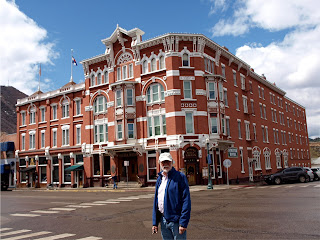The scenery changed from brambles, brush and purple
snow caps to red rock formations and now, 300 miles later, we are in Flagstaff,
Arizona, one of our favorite places.
There is something for everybody, here.
It’s a college town, there is sunny heat, snow, a ski area, observatory,
old town, a 2 to 3-hour long Fourth of July Parade and park festivities. Oh, and it rains everyday. Not for long, but every day. That isn’t the good news, fyi.
Lore has it that the name “Flagstaff” developed over time
based upon the stripping and whittling of a ponderosa pine to be used as a
flagpole to display the US flag for the 100th anniversary of our
country on July 4, 1876. Before this,
the town was named Antelope Springs and Old Town. It was settled on an old dirt road that lead to
California and the main industries were timber and ranching. The railroad was laid through the town and
that and Route 66 put Flagstaff permanently on the map. It is often called the “City of Seven
Wonders” based upon surrounding forests, high peaks, canyons and a huge
crater. The Lowell Observatory houses
the Clark Telescope. Pluto was
discovered and the moon was mapped for the Apollo missions using this
telescope. (Mickey was discovered after
that.)
 |
| Weatherford Hotel with pine cone |
In 1900, John Weatherford opened the Weatherford Hotel, a
historical landmark in Flagstaff. It has
been visited over the decades by the famous and the infamous, politicians to
gunslingers, and is still open for business.
You know how they lower the ball on New Year’s Eve at midnight in
NYC? Not to be outdone, in 1999, the townsfolk
began the tradition of “Lowering the Pine Cone” from the roof of the
Weatherford Hotel at midnight on New Year’s Eve. We attended this event last year, agreeing
that, whereas Time Square in NYC on New Year’s Eve may easily be left off the
bucket list, one may not go through an entire lifetime without witnessing the “Lowering
of the Pine Cone.” |
| "Ten... nine... eight... Happy New Year!" |
 |
| New Year's Eve in Flagstaff |
Finally, after having visited Flagstaff at least a half
dozen times, we made it to Black Bart’s Steakhouse, Saloon and Musical Revue! Yes, they were open, a miracle! They serve great lamb, beef steaks and cold
brews and the wait staff sings and entertains, backed up by the talented piano
player. We were seated near the huge
log-burning fireplace and the evening was a really unique, cozy experience.
My Beloved had gone long enough without a pizza and was
therefore on a mission. It ended happily
at Fat Olives, a seriously authentic Italian restaurant. The centerpiece is the wood-fired oven, built
in Italy by a fifth-generation Italian family from stones obtained in part from
Mount Vesuvius.
 |
| Fat Olives wood fired oven from Italy |
 |
| Wood fired pizza! |
We are on our way home, now, Tuesday April 12th. Our internal homing devices know the way to
and from Flagstaff, Arizona with our eyes closed. What a wonderful adventure this has
been. Now, let’s see what we can dream
up next!




















